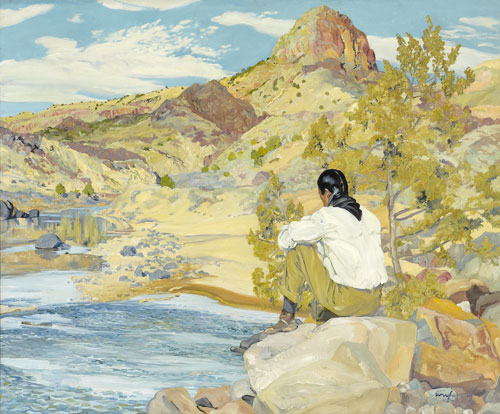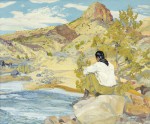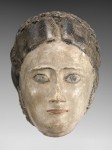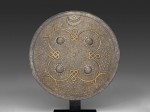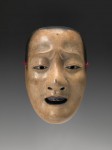Among the significant acquisitions accepted by the Virginia Museum of Fine Arts’ board of trustees on June 17 are a painting of a Pueblo Indian by a leading member of the Taos Society, an Egyptian mummy portrait mask, a South Asian shield of steel, gold and silver, and a Japanese Noh mask.
Native American Painting
Walter Ufer (1876-1936) On the Rio Grande (Rio Grande November), 1927, oil on canvas, 25 x 30 ins., J. Harwood and Louise B. Cochrane Fund for American Art.
Walter Ufer’s vibrant On the Rio Grande marks the first work by a member of the famed Taos Society of Artists to be acquired for VMFA’s collection. As the leading exponents of figurative painting in early 20th-century America, the Taos Society was founded in 1915 and disbanded in 1927, the year this work was painted. Ufer joined the group in 1917, specializing in portraits of Pueblo Indians and vivid landscapes fluidly painted in a high-key palette with impastoed brushwork. On the Rio Grande melds Ufer’s sensitive portrayal of a native figure with a lushly rendered New Mexico setting in all its remarkable colors and textures. The artist, a strong supporter of individual freedoms and a devout Socialist (he was a close friend of Leon Trotsky), was deeply concerned with the plight of the Pueblo Indians and what he viewed as their centuries-long oppression intended to eradicate their racial and cultural identities. This emphasis on native “race pride” gained Ufer a contemporary reputation for work that was considered the most sympathetic collective portrait of Native Americans to date.
Ancient Egyptian Mask
Mummy Portrait Mask of a Woman, Egyptian (Roman Period), ca. 130 CE, plaster, glass, pigment. Adolph D. and Wilkins C. Williams Fund.
This wonderfully evocative face is not a true portrait but a generic image of a beautiful, fashionably coifed young woman. The sculpted plaster head has glass eyes and added pigment and was originally attached to a mummy board placed over the deceased. Such masks had been used in Egyptian burials since the First Intermediate Period (ca. 2000 BC), but the hairstyle dates this example to the reign of Emperor Hadrian (117 – 138 AD), when Egypt was part of the Roman Empire. The mask is an important addition to VMFA’s distinguished collection of Egyptian art, which already includes a mummy mask from the Ptolemaic period (323 – 30 BC). This mask soon will be displayed in the museum’s Hellenistic gallery, where it joins other works of art that explore the complex interactions between local traditions (such as burial customs) and Graeco-Roman artistic conventions.
South Asian Shield
North India, Punjab, perhaps Patiala, Koftgari Shield (Dhal), 19th century, steel, gold, silver, 22 ¼” diameter. Adolph D. and Wilkins C. Williams Fund.
A mesmerizingly ornate Indian shield enhances the arms and armor holdings of VMFA’s world-class South Asian collection. The shield’s convex blued-steel surface shimmers with filigree-like arabesque patterning inlaid in gold and silver in a technique called koftgari, similar to damascene in the West. Further animating the shield’s face are four gold-inlaid snakes, intertwined in a knotted pattern around hemispherical bosses, and a plaque that combines solar, lunar, and floral motifs. A large and stunning example of the Indo-Persian shield called a dhal, similar to the Western buckler; it was probably produced in the 19th century in northern India’s Punjab region. Before coming to Richmond, it was in Torrisdale Castle, Argyll, Scotland, likely brought there either by its builder Major General Keith MacAlister of the Madras Cavalry, or by its subsequent owner Peter Hall, founding partner of the British India Steam Navigation Company.
Japanese Noh Mask
Deme Yukan Mitsuyasu 出目友閑満庸 (1577 -1652), Noh Mask: Chujo, 17th century, Japanese, Edo period (1615-1868), cypress with pigment on gesso, 7⅞ x 5-5/16 x 2⅝”. Adolph D. and Wilkins C. Williams Fund.
This Noh mask, known as Chujo, is characterized by realistic facial features, an open mouth, furrowed eyebrows, and a restrained yet powerful expression. Carved from a single piece of wood, the mask is coated with a layer of gesso and painted in ink and color for detail. Noh, a form of performance that developed in the 14th century and became more popular in the 17th century, combined dancing, music, and poetry. On the stage, male actors wearing masks played both male and female roles. All the Noh masks are designated for particular characters. The Chujo mask is believed to be modeled after Ariwara no Narihira (825-880), a well-known poet in the Heian period (794-1185) and a middle-ranking captain, Chujo in Japanese, in the imperial court.
Additional Acquisitions
African
• Diviner’s Slit Gong with Power Attachments, 19th–20th century, Yaka culture (Democratic Republic of the Congo), wood, glass beads, mirror, coin, pigment fiber, cloth, medicinal ingredients, 15¼”h. Adolph D. and Wilkins C. Williams Fund.
• Power Figure (Nkisi), 19th–20th century, Yaka Culture (Democratic Republic of the Congo), wood, fiber, cloth, medicinal ingredients, 4¼”h. Adolph D. and Wilkins C. Williams Fund.
• Royal Drinking Horn, 19th–20th century, Bamum culture (Cameroon), buffalo horn, 15”long. Adolph D. and Wilkins C. Williams Fund.
• Esther Mahlangu (South African, b. 1935), commission to create two paintings, Adolph D. and Wilkins C. Williams Fund.
American
• Arthur Dove (American, 1880-1946), Mars Orange and Green, 1936, watercolor, pen, ink and pencil on paper, 4 x 6”. John Barton Payne Fund.
• Albert Herter (American, 1871-1950), Spring Reverie, 1901, watercolor, gouache, and pencil mounted on board, 17¾ x 11⅞”. John Barton Payne Fund.
• Clare Leighton (American, born England, 1898-1989), Gristmilling and Marble Quarrying (from New England Industries set for Wedgwood Queen’s Ware), 1952, transfer-printed creamware, ea: 10⅝” dia. Gift of Stephen Borkowski, Provincetown, Mass.
• Janet Scudder (American, 1869-1940), Little Lady of the Sea, 1913, bronze, 85 x 25 x 28”. J. Harwood and Louise B. Cochrane Fund for American Art.
• Louis Comfort Tiffany (American, 1848-1933), designer, for Tiffany Studios (1902-1932), manufacturer, Vase, ca. 1910, Corona, New York, 4-11/16 x 6¼” dia. Gift of Charles L. Vincent, Falls Church, Va., in memory of his late wife, Mary.
Mellon Collection
24 works from the life estate of Paul Mellon, Upperville, Va. Donor: Collection of Mr. and Mrs. Paul Mellon.
• American Drawings
o Henry W. Waugh (American, 1835-1865): From the Buggy, pen and sepia ink on paper, 5⅝ × 8”; A Horse (In shafts, facing left), graphite on paper, 4 x 5”; Two Horses (In shafts, facing left), graphite on paper, sheet: 4¾ × 5⅞”; Animal Studies, five on one sheet, graphite on paper, various sizes.
• English Sporting Paintings
o Henry Thomas Alken (English, 1785-1851), four works from the series A Steeplechase at Market Harborough, Leicestershire, ca. 1840-50, oil on panel, each 10 × 14”: The First Fence; Taking a Brook; Bad Fall at a Paling Fence; and Coming up to the Finish
o Sir Edwin Landseer (English, 1802 –1873), A Terrier on a Step, oil on canvas, 7⅛ × 8⅛”
o Sir Alfred J. Munnings (English, 1878–1959): Study of the Pytchley Bitch, 1928, oil on panel, 16 × 16”; Pilot, one of Freeman’s Hunters, Pytchley, Brixworth, 1928, oil on board, 16 × 8¼”
• European Paintings
o Kees van Dongen (Dutch, 1877-1968), Haystacks, n.d., (possibly ca. 1904-05), oil on canvas, 19⅝ x 25½”
o Raoul Dufy (French, 1877-1953), L’Atelier au bouquet, 1942, oil on canvas, 25⅝ × 31⅞”
o Paul Gauguin (French, 1848-1903), Still Life with Bowl, ca. 1889, oil on canvas, 8 x 12⅜”
o Vincent van Gogh (Dutch, 1835-1890), Daisies, Arles, 1888, oil on canvas, 13 x 16½”
o Camille Pissarro (French, 1830-1903), The “Royal Palace” at the Hermitage, Pontoise, 1879, oil on canvas, 21⅜ x 25⅞”
o Rene Princeteau (French, 1843-1914), Le Tilbury, oil on canvas, 15⅞ x 22⅛”
o Georges Seurat (French, 1859-1891), Houses and Garden, ca. 1882, oil on canvas, 11 x 18½”
o Henri de Toulouse-Lautrec (French, 1864-1901), Norfdac, 1881, oil on panel, 9¼ x 5⅝”
• European Drawings
o Leon Bakst (Russian, 1866-1924), La Chasse, pencil and watercolor on paper, sight: 12⅛ x 18⅝”
o Eugène Boudin (French, 1824-1898), recto: Deux Bretonnes en costume, verso: untitled
graphite and watercolor sketch, 10½ x 8⅛”
o Alexandre-Gabriel Decamps (French, 1803-1860), Studies of Hounds, black chalk on grey paper, 6¾ x 10⅞”
o Georges Seurat, Enfant à l’echarpe, black conte crayon, sight: 6½ x 4”
o Henri de Toulouse-Lautrec, Le depart, pen and ink and pencil, sight: 6 x 9¾”
Modern & Contemporary
• Michael Lease (American, born 1972), FTLW#03292008 (Bellevue Chinese Witch Hazel), 2008, framed: 21 x 27¼”, sheet: 17¾ x 24”. Aldine S. Hartman Fund.
• Brittany Nelson (American, born 1984), Gelatin Relief #1, 2014, archival inkjet print, ed. 1/1, framed: 31 x 31⅛”, sheet: 27 x 27”. Aldine S. Hartman Fund.
Photography
• James Abbe (American, 1883-1973) Actress Jane Cowl, 1922, gelatin silver print, 10 x 8”. Gift of Richard Kremer, Williamsburg, Va.
• Jessica Tarbox Beals (American, 1870-1942) [Cigar Store Figure], 1911, printed ca. 1927, gelatin silver print, 4-1/16 x 3-15/16”. Gift of Richard Kremer, Williamsburg, Va.
• Ferenc Berko (American, born Hungary, 1916-2000), Train Lines and Wires, ca. 1949, gelatin silver print; printed c.1949, 8⅜ x 7⅞”. Adolph D. and Wilkins C. Williams Fund.
• Eve Besnyo (Dutch-Hungarian, 1910–2002), Peacock, 1931, silver print, 8¼ x 7”. Kathleen Boone Samuels Memorial Fund.
• Felix Bonfils (French, 1831-85), Egypt, ca. 1880s-1900, albumen photograph, 7¾ x 10¼”. Gift of Richard Kremer, Williamsburg, Va.
• Robert Capa (American, born Hungary, 1913-1954), two gelatin silver photographs: Battle of Rio Segre, November 7, 1938, 7⅛ x 9½”; and Four-man Negro Jug Band, Hot Springs, AZ, 1940, 7½ x 9½”. Adolph D. and Wilkins C. Williams Fund.
• Imogen Cunningham (American, 1883-1976), Jose Limon at Mills College, 1939, silver gelatin photograph, sheet: 10 x 8”. Adolph D. and Wilkins C. Williams Fund.
• Andre De Dienes (American, born Hungary, 1913-1985), Sunday Morning, ca. 1950, gelatin silver print, 12½ x 10⅛”. Adolph D. and Wilkins C. Williams Fund.
• Arnold Eagle (American, born Hungary, 1909-1992), One Third of the Nation, Lower East Side, ca. 1935, vintage gelatin silver print. Adolph D. and Wilkins C. Williams Fund.
• Georgy Kepes (American, born Hungary, 1906–2001), Untitled, ca.1939, silver gelatin print. Kathleen Boone Samuels Memorial Fund.
• André Kertész (American, born Hungary, 1894-1985), two gelatin silver photographs: Paris, 1929, printed late 1950s-60s, image: 7⅝ x 9⅝”; Fire Escape, New York, November 8, 1949, printed in 1960, image: 13-15/16 x 10½”. Adolph D. and Wilkins C. Williams Fund.
• Ervin Marton, (American, born Hungary, 1912-1968) Untitled, ca. 1950, silver gelatin print. Kathleen Boone Samuels Memorial Fund.
• Cornell Somogyi, (American, born Hungary, 1910), two vintage silver gelatin photographs:
Untitled (Street Scene), 1936, vintage silver gelatin print; St. Endre Gypsy Dwelling, 1946, vintage silver gelatin print. Kathleen Boone Samuels Memorial Fund.
About VMFA acquisitions
These works of art were approved by the VMFA Board of Trustees in June 2014. VMFA is a state agency and a public/private partnership. All art is purchased with private funds from dedicated endowments. After VMFA’s board approves proposed acquisitions on a quarterly basis, the art becomes the property of the Commonwealth of Virginia to protect, preserve, and interpret.
About the Virginia Museum of Fine Arts
VMFA’s permanent collection encompasses more than 33,000 works of art spanning 5,000 years of world history. Its collections of Art Nouveau and Art Deco, English silver, Fabergé, and the art of South Asia are among the finest in the nation. With acclaimed holdings in American, British Sporting, Impressionist and Post-Impressionist, and Modern and Contemporary art – and additional strengths in African, Ancient, East Asian, and European – VMFA ranks as one of the top comprehensive art museums in the United States. Programs include educational activities and studio classes for all ages, plus lively after-hours events. VMFA’s Statewide program includes traveling exhibitions, artist and teacher workshops, and lectures across the Commonwealth. VMFA, a certified Virginia Green attraction, is open 365 days a year and general admission is always free. For additional information, telephone 804-340-1400 or visit www.vmfa.museum.
# # #
